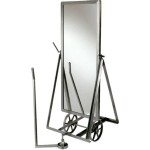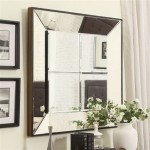The Enduring Allure of the Antique Cheval Mirror
The antique cheval mirror, also known as a full-length pivoting mirror, represents a significant piece of furniture history. Characterized by its distinctive design featuring a tall mirror suspended on a pivoting frame, it offers a full-body reflection and adds an element of elegance and sophistication to any interior. These mirrors, often crafted with meticulous detail and incorporating high-quality materials, provide valuable insights into the craftsmanship and design aesthetics of past eras.
Cheval mirrors experienced their peak popularity during the 18th and 19th centuries, finding favor in dressing rooms and boudoirs of the affluent. The pivoting mechanism allowed for adjusting the angle of the mirror, catering to individual preferences for viewing and dressing. The frames themselves often served as canvases for artistic expression, showcasing intricate carvings, inlays, and decorative embellishments. Examining these details provides a window into the social customs and fashion trends of the periods in which they were produced.
Beyond their functional purpose, antique cheval mirrors hold substantial collectible value. Their rarity, historical significance, and artistic merit contribute to their desirability among antique enthusiasts and interior decorators. The condition of the mirror, the quality of the frame, and the presence of original hardware significantly influence their market value. Careful evaluation of these aspects is crucial when assessing the worth of an antique cheval mirror.
Identifying Key Characteristics of Antique Cheval Mirrors
Distinguishing an antique cheval mirror from a more recent reproduction requires a keen eye and familiarity with period-specific design elements. Several key characteristics can aid in authenticating an antique piece. One of the first aspects to consider is the type of wood used in the frame. Mahogany, walnut, and rosewood were commonly used in earlier examples, reflecting the availability and popularity of these materials at the time. Cheaper woods or composite materials are more indicative of later production; however, always keep in mind that some antiques may have been later modified or repaired using different materials.
The construction techniques employed also offer clues to the mirror's age. Hand-cut dovetail joints, evident in the frame's corners and other structural elements, signify traditional craftsmanship. Machine-made joints, on the other hand, point to more modern manufacturing methods. Furthermore, the presence of aged patina on the wood and the mirror's surface can suggest its authenticity. Patina, a natural accumulation of dust, oils, and environmental factors over time, gives the finish a subtle texture and depth that is difficult to replicate artificially.
Examining the mirror glass itself can reveal further information. Antique mirror glass often exhibits slight imperfections, such as subtle waviness or bubbles, due to the manufacturing processes of the time. Modern mirror glass is typically much flatter and more uniform. The presence of foxing, small dark spots caused by oxidation of the silver backing, is another indicator of age, although this can also occur in more recent mirrors under certain environmental conditions.
Exploring Different Styles and Periods
Antique cheval mirrors are found in a wide range of styles, each reflecting the prevailing aesthetic tastes of its era. Queen Anne cheval mirrors, popular in the early 18th century, feature elegantly curved lines, cabriole legs, and minimal ornamentation. The focus is on the graceful silhouette and the quality of the wood. These mirrors are often smaller in scale compared to later examples.
During the mid-18th century, Chippendale cheval mirrors emerged, characterized by their more elaborate designs and intricate carvings. These mirrors often incorporated Rococo motifs, such as scrolls, shells, and acanthus leaves. Some Chippendale cheval mirrors also featured elements inspired by Chinese design, reflecting the popularity of chinoiserie at the time. The frames were typically made of mahogany and finished with a rich, dark polish.
The late 18th and early 19th centuries saw the rise of Neoclassical cheval mirrors, influenced by the rediscovery of classical Greek and Roman art. These mirrors feature clean lines, symmetrical designs, and restrained ornamentation. Common decorative elements include fluted columns, swags, and medallions. Mahogany and satinwood were popular choices for frames, often inlaid with contrasting woods to create intricate patterns.
Victorian cheval mirrors, prevalent in the 19th century, are known for their opulent designs and elaborate embellishments. These mirrors often feature heavily carved frames, ornate details, and decorative hardware. Rosewood, walnut, and mahogany were commonly used, frequently finished with dark stains and varnishes. The mirrors themselves were often larger and more imposing than earlier examples, reflecting the Victorian penchant for grandeur.
Caring for and Preserving Antique Cheval Mirrors
Proper care and preservation are essential for maintaining the value and beauty of antique cheval mirrors. The delicate nature of the mirror glass, the wood frame, and the pivoting mechanism requires careful handling and appropriate cleaning techniques. Neglecting these aspects can lead to irreversible damage and diminish the mirror's historical significance.
When cleaning the mirror glass, avoid using harsh chemicals or abrasive cleaners. A gentle solution of warm water and mild dish soap, applied with a soft cloth, is usually sufficient to remove dirt and grime. Be sure to dry the glass thoroughly to prevent water spots. Never spray cleaning solutions directly onto the mirror, as this can damage the silver backing. Instead, apply the solution to the cloth and then gently wipe the mirror surface.
The wooden frame should be cleaned with a soft, dry cloth to remove dust and dirt. Avoid using furniture polish or waxes, as these can build up over time and create a dull, sticky residue. If the frame requires more thorough cleaning, consult with a professional furniture restorer. They can recommend appropriate cleaning products and techniques that will not harm the original finish.
The pivoting mechanism should be inspected regularly and lubricated as needed to ensure smooth operation. Use a light oil or silicone-based lubricant, applied sparingly to the pivot points. Avoid using excessive amounts of lubricant, as this can attract dust and dirt. If the mechanism is stiff or difficult to operate, consult with a professional furniture repair specialist. They can diagnose the problem and recommend appropriate repairs.
Protecting the mirror from direct sunlight and extreme temperature fluctuations is also crucial. Prolonged exposure to sunlight can cause the wood to fade and the mirror glass to deteriorate. High humidity can also damage the frame and the silver backing of the mirror. Store the mirror in a cool, dry place away from direct sunlight and sources of heat or humidity.
Furthermore, when moving or transporting an antique cheval mirror, take extra precautions to prevent damage. Wrap the mirror glass in protective padding, such as bubble wrap or moving blankets. Secure the frame with straps to prevent it from shifting during transit. Consider using a professional moving company that specializes in handling antique furniture. Their expertise and equipment can ensure that the mirror arrives at its destination safely and undamaged.
Finally, consider insuring the antique cheval mirror against damage or loss. Consult with an insurance agent who specializes in fine art and antiques. They can assess the mirror's value and recommend an appropriate insurance policy. Regular appraisals can help ensure that the insurance coverage remains adequate as the mirror's value fluctuates over time.
Huge Victorian Cheval Mirror Large Tilting Dress 2950 00 Yvonne Sanders Antiques Ltd Auckland Furniture

120 Antique Cheval Mirrors For Ingantiques Co

Vintage Cheval Mirror Wells Reclamation

Antique Mahogany Cheval Mirror Dressing Large Chevel Antiques Georgian Furniture Regency Victorian

Antique Cheval Mirrors

Antique Mahogany Cheval Mirror C1920 261183 Www Castleforgeantiques Co

Qw Amish Antique Oval Cheval Mirror Quality Woods Furniture
French Antique Wooden Cheval Dressing Mirror

Antique Cheval Mirrors

Victorian Mahogany Cheval Mirror Over 500 Pieces Antique Furniture








